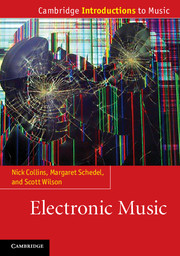Book contents
- Frontmatter
- Contents
- List of illustrations
- List of Tables
- Acknowledgments
- Chapter 1 Introduction
- Chapter 2 Recording technologies and music
- Chapter 3 New sounds and new instruments: Electronic music up until 1948
- Chapter 4 The post-war sonic boom
- Chapter 5 From analog to digital
- Chapter 6 Into the mainstream
- Chapter 7 Synth pop
- Chapter 8 Electronic dance music
- Chapter 9 Continuing the classical?
- Chapter 10 Experimental electronica
- Chapter 11 Sound art
- Chapter 12 Further connections
- Chapter 13 Live electronic music
- Chapter 14 Conclusions
- Notes
- Index
- References
Chapter 4 - The post-war sonic boom
Published online by Cambridge University Press: 05 May 2013
- Frontmatter
- Contents
- List of illustrations
- List of Tables
- Acknowledgments
- Chapter 1 Introduction
- Chapter 2 Recording technologies and music
- Chapter 3 New sounds and new instruments: Electronic music up until 1948
- Chapter 4 The post-war sonic boom
- Chapter 5 From analog to digital
- Chapter 6 Into the mainstream
- Chapter 7 Synth pop
- Chapter 8 Electronic dance music
- Chapter 9 Continuing the classical?
- Chapter 10 Experimental electronica
- Chapter 11 Sound art
- Chapter 12 Further connections
- Chapter 13 Live electronic music
- Chapter 14 Conclusions
- Notes
- Index
- References
Summary
After the previous chapter, which spanned some centuries of gradually accelerating activity, we'll slow down our pace and take a look at some developments after the end of the Second World War. This makes sense, as looking forward into the 1950s we see an astonishing number of separate strands develop, each at a fevered pace. The explosion of prosperity and technology after the war created many new possibilities, and the development of electronic music during this period (sometimes referred to as a “golden age”) reflects this.
A world of disparate centers
From the vantage point of today, it is difficult to imagine the world of the 1950s. Although post-war peace efforts such as the establishment of the United Nations (UN) in 1945 were representative of a broad trend toward internationalization, the world remained relatively unconnected by today's standards of instant communication and easy transmission of data. The widespread development of post-office mechanization didn't begin until the mid-1950s. While easier than it had hitherto been and naturally less restricted than during the war, travel was more expensive and less frequent than it is today. For example, although there were domestic flights throughout the US by the 1950s, they would cost around $100 – about $800–$1,000 in 2012 money – and were thus just barely within the reach of ordinary people. Jet travel only became practical in the late 1950s. It was only 1956 that the first transatlantic telephone cable was laid, replacing the previous unreliable and extremely expensive radio telephone service.
- Type
- Chapter
- Information
- Electronic Music , pp. 45 - 64Publisher: Cambridge University PressPrint publication year: 2013

